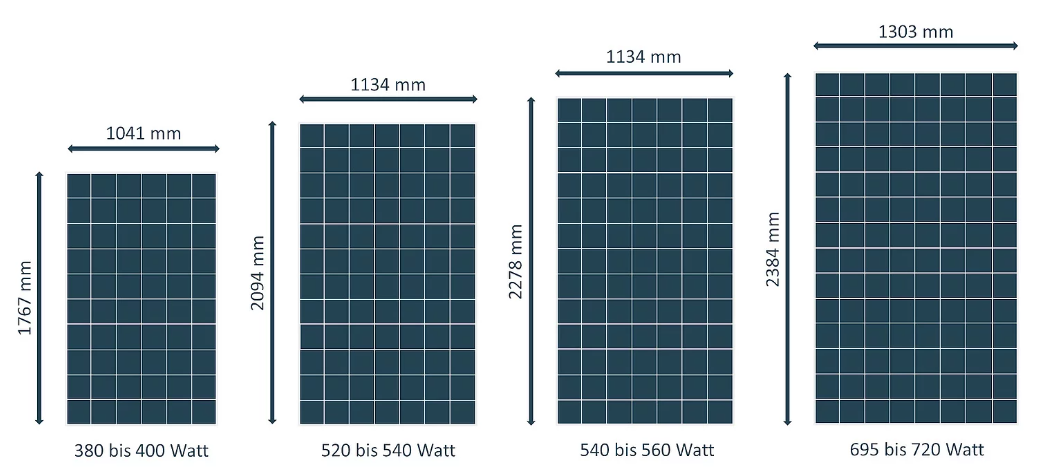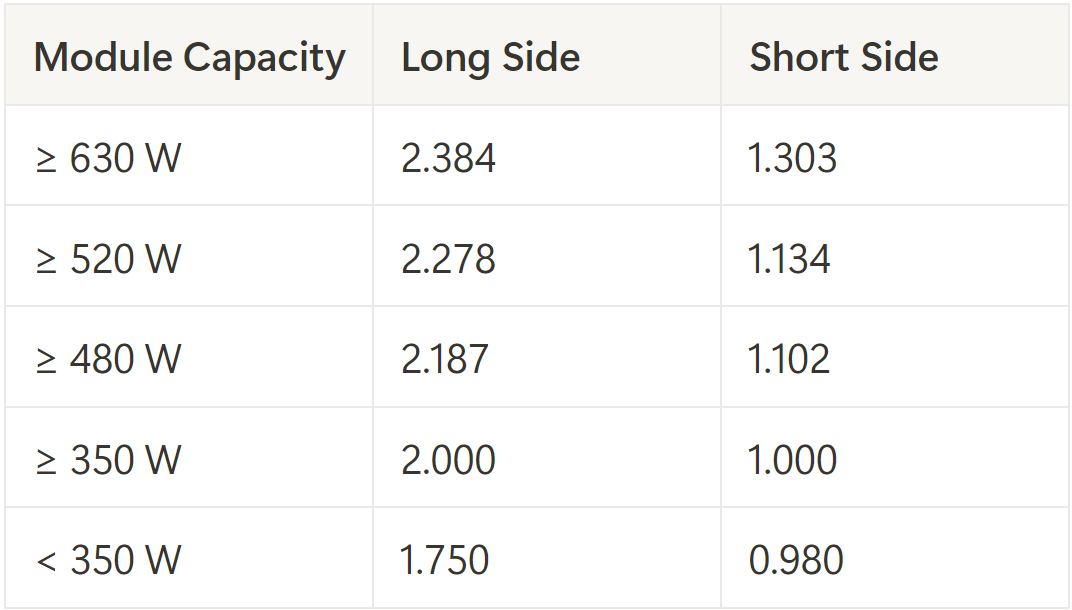A Practical Solution for PV Module Dimension Variability
Classifying PV Module Dimensions Based on Power Capacity
As the solar industry continues to evolve rapidly, we face a high variety of photovoltaic (PV) modules with different power capacities and dimensions. With advances in cell technology and efficiency, newer models of PV modules have significantly higher power capacities, but this has also led to a greater variety of physical dimensions.
This variability can generate challenges for the estimation of operational aspects, such as cleaning strategies and estimating material requirements for projects where albedo enhancers are applied. For instance, accurately estimating the time and resources required for cleaning large PV projects depends on the module dimensions. Similarly, knowing module sizes can streamline the implementation of albedo enhancers. However, given the broad range of dimensions in today's market, it can be difficult to easily classify these modules according to their power capacity. To address this issue, we conducted an analysis of a large dataset of commercially available PV modules.
The Challenge of Standardization
Since 2017, efforts have been made to standardize the dimensions of the latest high-capacity modules, particularly frame sizes and mounting hole positions, to facilitate easier installation on substructures. However, this standardization has mainly focused on newer models, leaving older installed modules out of this grouping. The final module size is often dictated by the number of cells, cell formats, and module frame sizes, with larger modules and formats helping to reduce costs per watt.
To address this issue, our analysis identified patterns within a large dataset provided by the California Energy Commission. This database includes information on over 21,000 commercially available modules. However, we noticed that the size data for the higher capacity modules (over 500 W) was incomplete, so we investigated further and manually filled in the missing information for this range. This ensured a more complete and accurate representation of module sizes, helping us to provide a practical solution for both older and newer modules.

Figure 1: New commercial module dimensions standard (Graphic: energie-experten.org)
A Step Function for Module Classification
We propose a simple step function to classify module dimensions based on their power capacity. This solution is based on the trends identified in the data, where categorizing modules into different capacity ranges allowed us to provide reasonable estimates of their dimensions. These estimates reflect the actual sizes of commercially available modules, offering a practical approach for operational and planning purposes. Please note that these values are the predefined defaults used in PVRADAR, but users can modify them if necessary.
The proposed step function is as follows:

- ≥ 630 W Range: This is the newest group, where the impact of size standardization is most noticeable. Nearly all modules in this capacity range conform to the same dimensions, though it’s expected that these sizes will continue to decrease as technology advances. Future adjustments to this classification will likely be necessary to reflect these changes.
- 520 - 630 W Range: Despite ongoing efforts to standardize module sizes within this range (resulting in two primary sizes), many of the modules already installed are larger. Based on our data, this range reflects significant variation, so we have opted to assign the larger of the standard sizes to represent this category.
- 480 - 520 W Range: Modules in this range are expected to see continued growth in installations. Their dimensions are distinct from other ranges, making it necessary to classify them separately. These modules, though close in size to the next category, are easily distinguishable.
- 350 - 480 W Range: While this range displays less variability compared to lower-capacity modules, the number of installations in this range is unlikely to grow significantly. The majority of these modules share similar dimensions, making the 1 x 2 meter size a reliable representation of this group.
- Modules below 350 W: These modules are no longer common in commercial-scale projects, as they were installed many years ago. Due to technological advances, modules in this range exhibit a wide variety of sizes. Therefore, an average dimension was selected to represent this variability effectively.
Visualizing the Data
The graph below (Figure 2) summarizes the results of our analysis. It shows the relationship between module dimensions and power capacity, comparing commercially available modules (both short and long sides) to the standardized sizes proposed in our step function.

Figure 2: Relationship between Module Dimensions and Power Capacity
This visualization highlights the patterns we observed during our analysis. As expected, the dimensions of the modules increase as power capacity rises. However, the introduction of standardization is most evident in the higher-capacity modules, where size variability decreases significantly.
Conclusion
In conclusion, while classifying PV module dimensions based solely on power capacity presents challenges, our approach offers a simple yet effective solution. This method supports our calculations related to cleaning activities and albedo enhancer installations by providing a practical framework for categorizing the wide variety of module sizes currently in the market. Although it's just one of many possible solutions, it effectively addresses the complexities generated by diverse module dimensions.
